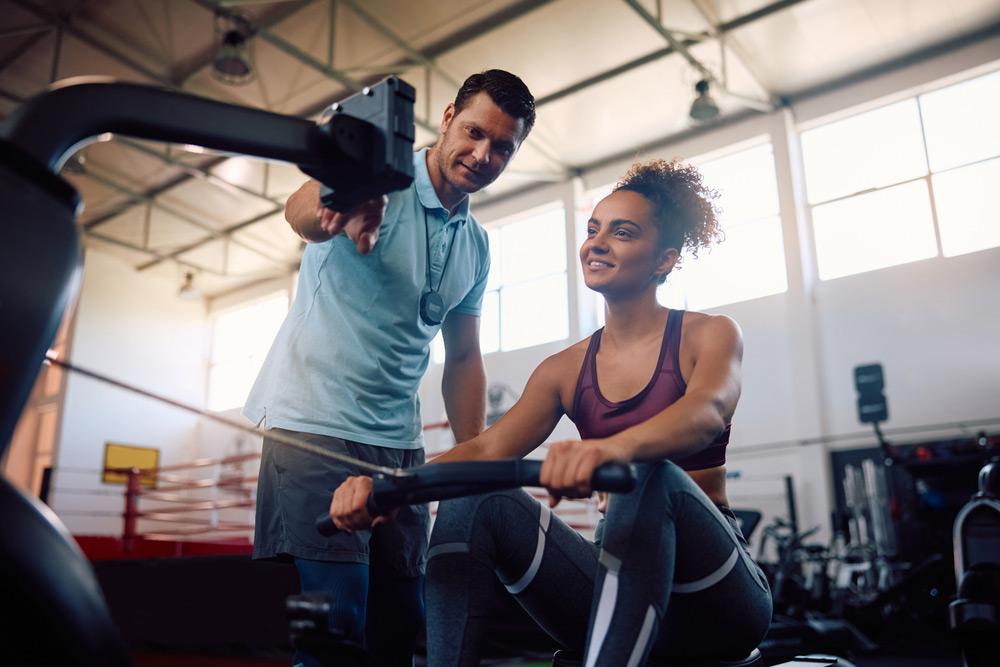 Content Warning: This article contains mentions of suicide.
Content Warning: This article contains mentions of suicide.
Setting goals can be fun—or it can be a big challenge. Should you set goals that you know you can achieve, or make a season goal that’s going to be a huge stretch? As an athlete, you likely want to win games or excel in competitions, but you also know that you can’t control how the rest of your team plays, or which competitors show up on the start line. Does that mean you shouldn’t set that goal?
The best way to achieve goals is to focus on the things that you can control, while striving for the big outcome goal that you may or may not achieve. And here, TrueSport Expert Betsy Butterick, a coach and communication specialist, is explaining the best way to break a big goal down into bite-sized, controllable chunks to give yourself the best chance for success.
Why does control matter to setting goals?
“It’s important to understand what’s within your control and what isn’t,” says Butterick. “In youth sport, we’re seeing athletes who are struggling with their mental health: There is a rise in anxiety and depression, and even an increase in suicide among young people. And we’ve seen that athletes who find themselves in crisis are often also disproportionately focused on elements that are outside of their control. Their goals are based on things that they can’t actually control.”
She explains that for athletes to stay goal-focused in a healthy way, it’s important to understand what is within their control and focus on that. “We can help athletes to feel more grounded or safe in whatever challenge they find themselves in by having conversations that allow them to identify what they can actively influence or control—even when a situation is largely outside of their control,” she says. It’s okay to have big goals, but it’s important to understand to what extent you can actually control the outcome of that goal.
Define success in a new way
If an athlete shifts to focusing on things that are within their control, it can change what success looks like. You may have assumed that success could only be measured in total numbers of goals, points, or wins, but success can be redefined to include the controllable factors that could lead to those bigger outcomes. “If we only measure success as whether you did or did not attain a set goal, that can be constricting,” says Butterick. “I often get athletes to think about what they can expect to see or feel in pursuit of their goal, and what needs to be true in order for them to give themselves the greatest opportunity to meet this goal. This helps us redefine what success looks like—it’s about the becoming, rather than the specific outcome.”
Butterick’s own high school career is an example of this thought process. As a young basketball player, she grew up dreaming of playing basketball at Stanford University. “That was where I wanted to go to school. I applied twice. I didn’t get in. But doing the work in high school, both academically and on the basketball team, as if I would get that opportunity to play for Stanford, enabled me to earn a Division I scholarship in basketball and get school paid for by sport. I didn’t achieve the goal of playing at Stanford, but I did a lot of really great work that led to an opportunity for success in a different way.”
How far should you stretch your goal?
As Butterick’s example shows, a goal shouldn’t be something you know you can achieve, it should be something that would be a stretch for you. Butterick suggests asking yourself: What would be uncomfortably exciting? “We need to experience that discomfort in order for growth to occur, but it needs to also feel exciting, because that’s the motivating piece that keeps us going when things get uncomfortable,” she says.
What’s outside your boat?
Once you have your big goal, it’s time to break it down into controllable components. “I like to tell the story of Charlie Jones, an NFL broadcaster who was brought on to cover the 1996 Olympics in Atlanta, Georgia,” Butterick says. “Jones was assigned to cover rowing, kayaking, and canoeing, which weren’t sports that many people were watching back then. He researched the sports extensively and started asking the athletes really specific questions about things like how their lane assignment would affect their race strategy, or what they would do if the wind shifted mid-race. And what he found is that all the athletes had the same response, and that response was ‘That’s outside my boat.'”
“Jones came to realize that this population of athletes had gotten very specific about what they could control and where they were willing to invest their time, energy, and effort,” she explains. “They learned to ignore what was outside of their boat, and therefore outside of their control.”
Make a Controllable List
Using Jones’ inside/outside your boat analogy, look at your big goal for the season. Butterick suggests making a three-column list. Put your goal at the top of the sheet, and then label the three columns as full control, some control, and no control. Take a few minutes and list out as many facets to the goal as possible and assign them to a column. For example, if you’re racing the 400-meter on the track, you can fully control your pre-race breakfast, but you can’t control the weather or which racers show up from the other schools.
 Once you have that initial list, Butterick suggests really thinking about each facet of the goal and where you’ve put it on the list. You might even want to do this exercise with a few teammates or as a team and compare notes. “What’s interesting is that as we look at the debrief, I find that some things will fall on the ‘side of the boat,’ where you can argue that it is controllable, or you can argue that it isn’t,” she says. “For example, playing time. Some athletes will say that playing time is something you can control, because if you ask your coach what you need to do to play, and then you do those things, you’re going to play. But other athletes will say that playing time is uncontrollable, because even if you do the things the coach says, there is no guarantee that you’re going to play, so it’s outside of your control.”
Once you have that initial list, Butterick suggests really thinking about each facet of the goal and where you’ve put it on the list. You might even want to do this exercise with a few teammates or as a team and compare notes. “What’s interesting is that as we look at the debrief, I find that some things will fall on the ‘side of the boat,’ where you can argue that it is controllable, or you can argue that it isn’t,” she says. “For example, playing time. Some athletes will say that playing time is something you can control, because if you ask your coach what you need to do to play, and then you do those things, you’re going to play. But other athletes will say that playing time is uncontrollable, because even if you do the things the coach says, there is no guarantee that you’re going to play, so it’s outside of your control.”
This breakdown can help you add to your ‘fully controllable’ list because you’re further breaking down the elements you listed initially. ‘Playing time’ may move to the ‘some control’ or ‘no control’ column, but you can add the list of things that the coach requires athletes to do to gain playing time, like showing up to practice on time every day, to the ‘fully controllable’ list.
Break Down the Fully Controllables into Action Items
Some elements of your goal that are within your control are easy to turn into action items, like ‘being on time for practice.’ Make a plan that ensures that you do arrive at the gym or practice pitch on time: This may include changing into your practice clothing before last period, or setting your alarm clock 15 minutes earlier so you’re not rushing to make it to an early practice.
But some controllables can be harder to break down. If your track goal is running the 400-meter in under 51 seconds, while you may not be able to control the time the clock shows, what elements of that goal can you control? “You can start to figure out what it would take to run under 51 and what benchmarks you need to hit to get there,” Butterick says. “What are the things that would put you in the best position to hit that in a race this season?” Things like strength training more regularly, asking your coach for help, hitting certain times in shorter distances during your workouts, and even prioritizing sleep and recovery more can be action items that you can control.
Breaking Down a Big Goal
You may have a big goal that seems so big that you don’t know where to start. In these cases, it can help to work backwards to get to the small, controllable action steps you need to take. Butterick sees this frequently with athletes she works with. For example, she recently worked with an athlete whose goal was to get drafted into the WNBA. “I asked her, ‘What would need to be true in order for this to happen?’ and we started to break it down,” Butterick says. “We looked at some of the draft criteria that teams tended to prioritize for her position, and we looked at her relative stats in those categories. Then, we made a list of what would need to be true this year in order to put her in the best position to potentially be drafted.” By the end of their session, they had a list of things that the young athlete needed to focus on at a daily, weekly, and season-wide level.
Once you have that list, ask yourself: What are you doing today to support your ability to excel in those areas?
Rewrite Your Big Goal
After making the list of action items to help that student potentially get drafted, Butterick also helped her rewrite her big goal into one that was more within her control. She changed her big goal from “get drafted” to “put myself in the best position to be the most desirable candidate for teams who are looking in the draft.”
Butterick explains that now, whether she gets drafted or not, she can succeed at her goal. “Getting drafted is not in her control. Teams are going to pick who they need based off of who leaves or where their team falls once the season’s over,” she explains. “There are so many elements that influence whether or not a player like her is going to be chosen. What she can control is putting herself in the best position to be the most desirable candidate for what teams are looking for come Draft Day.”
You may even find that as you break down all the steps required to hit your goal, the big goal you initially set simply won’t be possible for you at this time. That’s okay. “It’s common that once this is all laid out, the athlete realizes that the gap between where they are now and where they want to go is too big to bridge right now,” says Butterick. “This isn’t a bad thing: It means we can set a new goal that is achievable based on what we’ve learned.”
Make a Plan to Control for the Uncontrollable
Many athletes are great at being extremely specific and intentional about what it will take to reach their goal, but they don’t proactively think about when things don’t go according to plan. For example, in the case of the athlete hoping to make it in the WNBA draft, what will she do if she has a bad game, or misses a week of practice due to illness?
“As you do this goal-setting work, it’s important to consider what could realistically get in the way of your ability to do these action items you’ve listed on a daily basis,” says Butterick. “To give yourself the best chance of meeting or exceeding your goal, think about what could get in your way. Then, make a plan for what you’ll do when something happens that gets in the way of your action steps. This is really helpful because when one of those things that might pop up does happen, you already know how to handle it. You’re able to respond instead of react, and in doing so, you keep that bigger goal in the realm of possibility.”
___________________________
Takeaway
Setting a big outcome-based goal for the season or school year is great, but without smaller steps that are actually within your control, you likely won’t achieve your goal. Breaking a big goal down into the components that are within your control and making a plan to work on those pieces day-by-day is the best way to achieve that goal. You should also prepare for detours along the way by having a plan for what you’ll do when an uncontrollable setback occurs.



